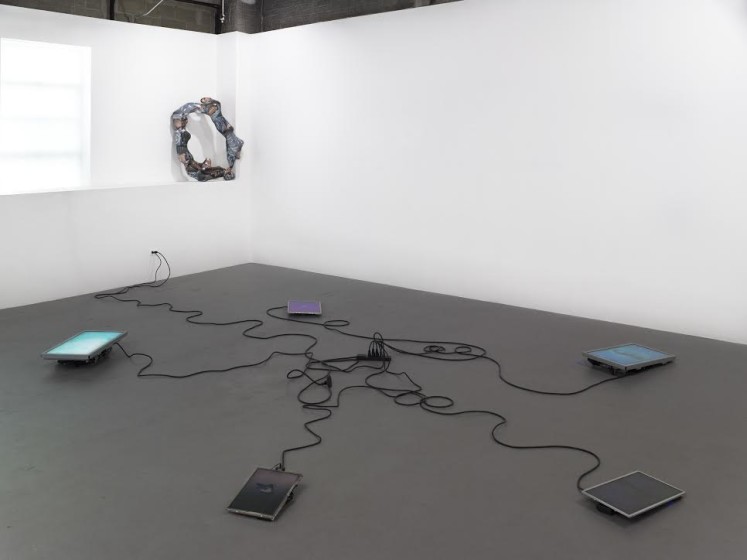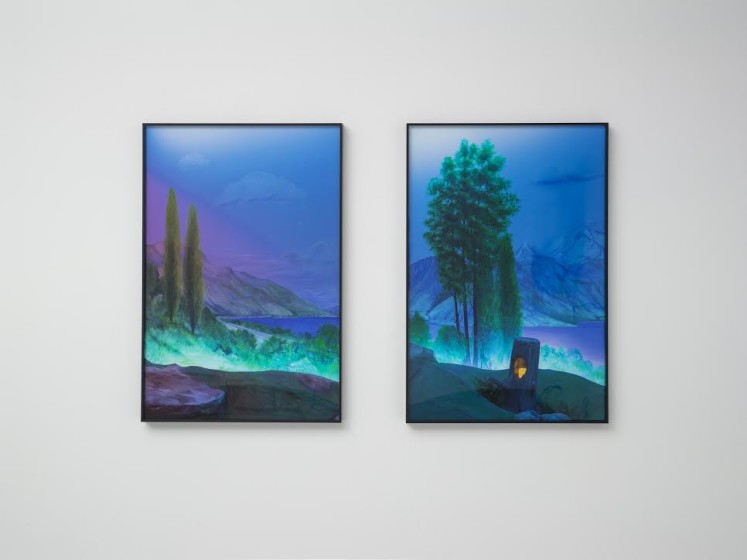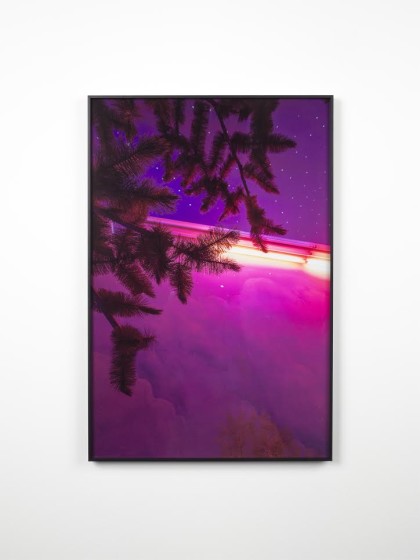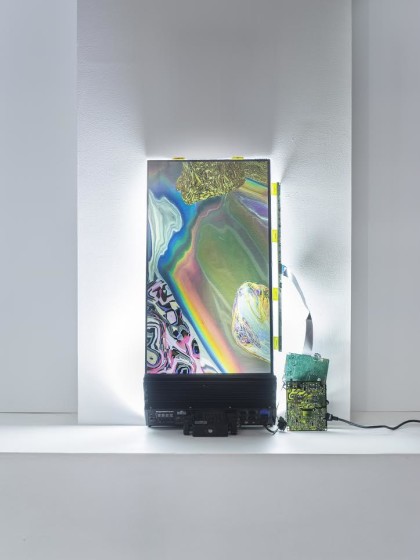Christopher Meerdo: Document
by Vanessa Gravenor
A group of screens lie upon a gray industrial floor, entangled within one another like roots in a rhizomatic structure. Each of the screens project different images of alternate digital worlds. Is this digital culture showing its inherent networked structure?
A flat first inquiry.
On the walls, one sees other screens deconstructed and ripped apart. There is an organism, perhaps a motherboard, or the screens internal thinking system, laid bare. It is connected, like an umbilical cord, to the monitor screen, which displays a psychedelic system (a kitschy sequence of images—for sure—reminiscent of Las Vegas).

These clusters of digital renderings make up the body of Christopher Meerdo’s exhibition, Erythrocyte Ghosts Filled with Quantum Dots Improve Cryogenics with Microarea Custom Freeze Thaw, currently on view at DOCUMENT in Chicago. Inspired by multiple sites in Nevada, the title is evocative of Meerdo’s wide range of research that spreads from new age genome projects to the exploration of underground bunker sites from the cold war.
Meerdo’s interests expand upon paranoiac fever that has its locus in cinematic fictions beginning at the turn of the twentieth century. This conspiracy fever is also linked to the apparatus of late capitalism, systematic of what Frederic Jameson calls our “new world system,” or cognitive mapping, which he elaborates at length on in The Geopolitical Aesthetic. He explains in the introduction:
We map our fellows in class terms day by day and fantasize our current events in terms of larger mythic narratives, we allegorize our consumption and construction of the object-world in terms of Utopian wishes and commercially programmed habits—but to that must be added what I will now call a geopolitical unconscious. This it is which now attempts to refashion national allegory into a conceptual instrument for grasping our new being-in-the-world.
This new sense of being in the world, disrupted by technological systems and “simplified” in the aftermath of the cold-war, gets to the heart of a sense of living-with (mit sein) a collective world fear.
If one were to view the installation of Erythrocyte Ghosts as a product of living in the aftermath of a society turned paranoiac, one can glimpse a cinematic arc gone awry. This tangential swerve is reflected in Meerdo’s interest with trans-human sciences, a subject that ties the work into a type of intellectual knot. Caught between a theology of eugenics and social progressiveness, trans-humanism looks to the betterment of society by technological and scientific means.

Enter the phantom of cryogenics.
As explained in a text associated with the exhibition, Meerdo elaborates: “Older generation cryonicists look to advancements in nano-technological individualized cellular repair advancements as a possibility for biological immortality.” While these philosophies have not reached their predicted peak, they advocate for the preservation of part of the human form (the head in one case), as a way to end death and preserve “life” as they understand it.
All of these allusions are lurking in the background of Meerdo’s photographic structures that inevitably (and ironically!) boil down to fundamental humanist fears. Reflected in the colors, a black-lit purple hue, the glow of hollow florescent yellow, the lights to the screens and prints hum at frenetic beats. This alternate beat, evocative of a post-mortem decay, gets under the skin of Western city life in Nevada—perhaps a rotting dream deferred.

Custom display monitor, media player, 1’33” loop, courtesy of the artist
Thinking of life beyond death, which often produces pitfalls rather than releases, has, however, been at the forefront of contemporary philosophical thought since the expanding discourses of Speculative Realism, post-humanism, and not to mention cyber feminism.
These theories encourage society to think beyond rather than within the confines of empirical thought. This, it seems, is where Meerdo is at the precipice in his exhibition at DOCUMENT—challenging, and thereby revealing, thought clusters that wouldn’t otherwise meet. Between post-cold war imaging and futuristic visions, one wonders what the ethical implications of putting such matter together bring to the audience. Perhaps most, the show questions: what does a life without death look like? Moreover, can one find this futuristic vision in the computer generated imaging that run amuck throughout the show, such as looping temporalities that ebb and flow?

As Meerdo suggests, this deathless dreaming, perhaps an accelerated life, is a vision that already reigns, as elites involved in cryogenics wield power locked into generations of wealth laundering and casino production. With that being said, Meerdo seems to look onto this landscape, humanoid and industrial, with neither doom nor optimism. Which world is he on the side of production, the deathless paradise or the reality wasteland? As viewers, we are invited to dream both and become ethically entangled within this cognitive knot.
Vanessa Gravenor is a writer/artist/critic living between Chicago and Berlin. Her writings have appeared in ArtSlant, N.Paradoxa (International Feminist Art Journal), and Bad at Sports. She is currently a DAAD study fellow.